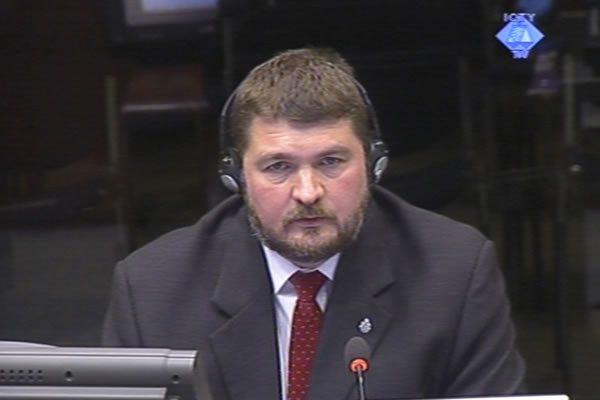Home
KARADZIC: SREBRENICA INVESTIGATION WAS ‘SLOPPY’
Dean Manning has testified at the trial of Radovan Karadzic. Manning headed a team of investigators who collected and classified forensic evidence on the executions and burial of Srebrenica victims in July 1995. Karadzic contends that the investigators were ‘sloppy’: they failed to take notice of the details that are glaringly obvious to him today – that the blindfolds and ligatures were made of satin and velvet and that some victims had their checkbooks and health insurance cards with them. At that time, the banks weren’t open and there was no health insurance in Srebrenica, Karadzic argued
 Dean Manning, witness at the Radovan Karadzic trial
Dean Manning, witness at the Radovan Karadzic trial The trial of Radovan Karadzic for genocide and other crimes in BH continued with the evidence of a senior inspector of the Australian police Dean Manning. Manning headed the investigation team that collected and classified forensic evidence on the executions and burial of Srebrenica victims in July 1995. The witness summarized his findings in three reports and testified at all Srebrenica trials. Today, Manning’s reports were admitted into evidence in the Karadzic case.
In his brief examination-in-chief, prosecutor Mitchell showed two ‘composite photos’ made of a series of individual photographs of blindfolds and ligatures. The prosecutor also showed a list of other artifacts like bullet casings, identity cards, watches and other personal belongings recovered from the mass graves at the sites in Ravnica, Glogova, Zeleni Jadar, Hadzici Put, Cancari Put, Branjevo and Pilica. He also showed aerial photos taken in September and October 1995, which helped the investigators determine that the victims’ bodies had been exhumed using earth moving machinery and transferred to new locations.
In the cross-examination, Karadzic claimed that the investigators were ‘sloppy’. Karadzic repeated his well-worn argument that for 45 months, there was heavy fighting in the Srebrenica enclave. During the terrain clear-up, the Serb forces buried the bodies of the dead Muslim fighters they found in the mass graves, Karadzic noted. Karadzic referred to the evidence of Drazen Erdemovic who was told by a guard at the Branjevo farm that there had been other ‘burials’ at that place earlier. Karadzic also reiterated his argument that eight members of Erdemovic’s detachment didn’t have time to kill up to 1,000 or 1,200 prisoners in the four or five hours they spent at the Branjevo farm.
The witness dismissed Karadzic’s argument that the Srebrenica mass graves were used to bury the dead found during the clean-up of the terrain, insisting that the graves ‘were dug secretly’ to bury the victims of the executions; many of them were blindfolded and had their hands tied behind their backs. The witness refused to entertain Karadzic’s calculations as to how many persons could be killed in so many hours. The accused then asked the witness what made the ‘work of the investigators in the field complicated’. It was the scale of the execution and the transfer of bodies from primary to secondary mass graves, the witness replied. If the graves hadn’t been dug up to transfer the bodies, the exhumation and identification of victims would have been a lot faster and easier, the witness remarked.
Karadzic also noted that one of the victims had his checkbook with him, ‘and banks at the time didn’t work’. Another victim had his health insurance card and ‘health insurance didn’t function’. A third victim had an identity card issued in Rogatica ‘but how did someone from Rogatica end up here’ when ‘they were known to have met a different fate’, Karadzic argued. In Karadzic’s view, the fact that some victims had personal documents and watches does not tally with the allegations that the Serb forces took personal documents and valuables from prisoners. The witness didn’t find it unusual because some survivors told him that they weren’t searched thoroughly before the execution.
In an almost desperate attempt to somehow contest the apparent meaning of the recovered blindfolds and ligatures, Karadzic suggested that Muslim fighters wore ‘ritual headbands’ given to them by their mothers before fighting. As Karadzic explained, they were ‘satin, velvet bands’, ‘fringed’, usually in light colors worn by the Muslim women in BH. During the investigation the witness saw, examined and photographed 448 blindfolds and 423 ligatures. In his reply to Karadzic, the witness said that the blindfolds were actually made of rejects from a textile factory, roughly cut into bands with uneven edges.
Radovan Karadzic’s trial continues tomorrow with the evidence of another witness.
Linked Reports
- Case : Karadzic
- 2012-03-05 KARADZIC AND MILOVANOVIC SHARE ‘TRUTHS AND MISCONCEPTIONS’
- 2012-03-01 ‘IGNORANT ADVISORS’ AND ‘INDESTRUCTIBLE’ MLADIC
- 2012-02-29 RADOVAN KARADZIC’S DIRECTIVES AND ‘INNERMOST WISHES’
- 2012-03-07 WITNESS: KARADZIC TOLD ME HE HAD ORDERED THE CAPTURE OF SREBRENICA
- 2012-03-08 WHY KARADIC DECLARED STATE OF WAR IN SREBRENICA
- 2012-03-12 KARADZIC: WE RAN THE STATE FROM A FIELD
